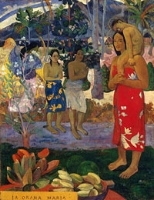Ann Allen cleared a path among the lush landscapes, languid forms and sometimes loopy symbolism of French painter Paul Gauguin in her guided tour of his works for participants in the Women's League visit to the Museum of Fine Arts on April 16.
The tour, organized by Dee Ippen of the Women's League, focused exclusively on the Gauguin show on exhibit at the MFA through June 20.
Allen, an adjunct lecturer at the MFA and a Women's League member, supplied details from Gauguin's life and set them in historical and cultural context as she proceeded through the four rooms of the museum's Gund Gallery. Gauguin (1848-1903) is best known for paintings from two trips to Tahiti, which was then a French colony.
The paintings in the show are arranged chronologically, beginning with "Landscape with Two Breton Women" and ending with "Women and White Horse." Freestanding indigenous sculptures that inspired Gauguin as well as his own tiki-like works in wood and glazed clay are displayed in the center of each room.
"He thought of himself as part Indian and part savage, thanks to his Peruvian father, and he was drawn to photographs of life in the South Seas that were brought to Paris," Allen said, pointing out some of the very photos that might have inspired Gauguin that were also on display. He was also reacting to a popular new technology, the camera.
"He didn't want to analyze light like the Impressionists, or mimic light like the photographers. He wanted to elicit insight, to use symbols to create mystery. Gauguin used objects to be suggestive and ambiguous so you yourself can enter into the art," Allen said.
As the group's collective eye grew used to Gauguin's tropical palette and his recurring personal symbols such as dogs, wolves, dodo birds and fantastical beasts in combination with portraits of Tahitian women, Allen explained how the harsh facts of the art market fueled some of Gauguin's more stagey tableaux.
Take those familiar floral print skirts -- they're a nod to French design, imposed on Tahitian women, she said.
"Gauguin painted a lost Tahiti that he hoped the French market would buy, not what he saw. In 'La Orana Maria' ('Hail Mary'), he made a Western religious subject, the Virgin Mary and Jesus, into a Polynesian fantasy. He changed the black volcanic gravel of Tahiti's beaches to rosy pink and purple sand. In 'There is the Temple,' he created a 'sacred mound' guarded by an Easter Island-type idol and surrounded by a fence in a culture where there were no real fences," she said.
Referring to a picture of three boys at a table laden with exotic Tahitian food, Allen noted that Gauguin didn't exactly immerse himself in Tahitian life -- he lived on canned tuna and Spam.
The sprawling, hallucinogenic "Where Did We Come From? What Are We? Where Are We Going?" fills an entire wall in the show, and Allen paused as the group absorbed its blue tsunami effect. Gauguin drank a walloping dose of arsenic after completing "Where," yet lived for five more years, painting despite progressive illness, debt and morphine dependency.
Both a product of his times and a pioneer, Gauguin might be considered as a predecessor to American pop artist, Andy Warhol, Allen suggested near the end of the two-hour tour. Like Warhol, Gauguin believed "art is life and life is theater. He didn't want us to figure him out. He wanted us to feel his work. And he brought us a new idea: art is reciprocal. Art is how you find something out about yourself," she said.






